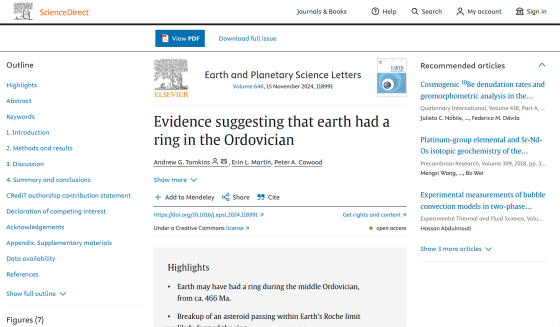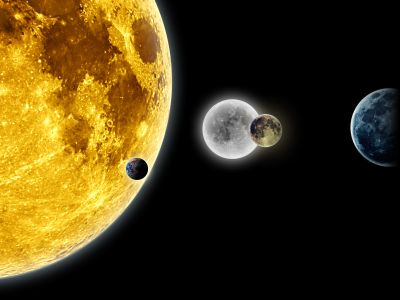Earth may have had Saturn-like rings about 450 million years ago

By Oliver Hull
It is well known that
Evidence suggesting that earth had a ring in the Ordovician - ScienceDirect
https://www.sciencedirect.com/science/article/pii/S0012821X24004230

Earth may have had a ring system 466 million years ago - Science
https://www.monash.edu/science/news-events/news/current/earth-may-have-had-a-ring-system-466-million-years-ago
Earth once wore a Saturn-like ring, study of ancient craters suggests | Live Science
https://www.livescience.com/space/earth-once-wore-a-saturn-like-ring-study-of-ancient-craters-suggests
Earth May Have Once Had a Ring That Slowly Fell From The Sky : ScienceAlert
https://www.sciencealert.com/earth-may-have-once-had-a-ring-that-slowly-fell-from-the-sky
The Ordovician period was a time when the diversity of life on Earth increased, with the appearance of mollusks such as nautiluses , arthropods such as trilobites , and fish with jaws. On the other hand, it was also a time when global cooling occurred, and a mass extinction occurred at the OS boundary , which is the boundary between the Ordovician period and the subsequent Silurian period .
It is known that a characteristic event that occurred during the Ordovician period was a sudden increase in meteorite impacts. Professor Andrew Tomkins , a planetary scientist at Monash University in Australia, and his team analyzed the traces of 21 craters that impacted the Earth during the Ordovician period.
As a result, it was found that all 21 craters had struck continents within 30 degrees latitude from the equator. At that time on Earth, 30% of the continents were located within 30 degrees latitude from the equator, but the remaining 70% of the continents had not been hit by meteorites. If meteorite impacts were random, this would be as biased as rolling a three-sided die 21 times and getting the same number on each.

The research team proposed a hypothesis that could explain both the 'rapid increase and bias in meteorite impacts' and the 'cooling of the Earth,' that is, 'the Ordovician Earth had a ring made of asteroid debris. The ring is thought to have been formed about 466 million years ago, when a large asteroid approached the Earth too close, exceeding the Roche limit , and was torn apart by tidal forces, forming the ring.
'Over hundreds of millions of years, parts of these rings gradually fell to Earth, producing the spike in meteorite impacts observed in the geological record,' Tomkins said. 'We also know that layers of sedimentary rock from this period contain a significant amount of meteorite fragments.'
The rings may not only have caused meteorites to fall on Earth, but also cast a shadow on the Earth's surface by blocking sunlight, causing severe cooling. It is also possible that the rapid climate changes caused by the rings created a need for evolution in organisms living on Earth during the Ordovician period, which resulted in accelerated evolution.
'The idea that Earth's rings could have influenced temperatures adds a new layer of complexity to our understanding of how extraterrestrial events have shaped Earth's climate,' Tomkins said.

By Oliver Hull
Furthermore, the idea that the cooling was caused by the formation of rings around Earth may provide clues for terraforming planets that are too hot. Tomkins argued that by bringing a large asteroid close to the orbit of Venus, it may be possible to artificially create 'Venus rings' to cool Venus.
Related Posts:
in Science, Posted by log1h_ik







